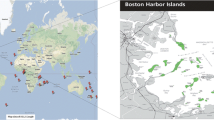Summary
Diamond (1975) formulated “assembly rules” for avian species on islands in an archipelago, which made a successful colonisation depend essentially on which other species were present. Critically examining these rules, Connor and Simberloff (1979) maintained that, in the Vanuatu (New Hebrides) archipelago, the field data on species distribution was quite compatible with a null hypothesis, in which species colonise at random with no species interaction. Their work was in turn criticised (Diamond and Gilpin (1982), Gilpin and Diamond (1982)) and a vigorous controversy has ensued.
Here we contribute a method in which a simple but hitherto neglected statistic is used as a probe: the number of islands shared by a pair of species, with its first and second moments. The matrix of these sharing values is given as a simple product of the incidence matrix, and its properties are examined — first, for the field data, and then in the random ensemble used by Connor and Simberloff (1979). It is shown that their constraints hold constant the mean number shared, so that any fall in the number that one pair of species share, due to their excluding each other, must imply a rise in the number shared by some other species pair-i.e., an aggregation.
Turning to the second moment of the numbers shared, it is shown that its value in the Vanuatu field data exceeds the largest value to be found in a sample of 1000 matrices, these latter being constructed so that they obey the Connor and Simberloff constraints but are otherwise random. This indicates that exclusion and/or aggregation effects are present in the actual distribution of species, which are not catered for by the null hypothesis.
The observed distribution thus emerges as much more exceptional than found by Connor and Simberloff (1979), and even by Diamond and Gilpin (1982), when examining the same ensemble. The reason for this disagreement are sought, and some cautions are offered, supported by numerical evidence, concerning the use of the chi-square test when the data points involved are mutually dependent.
Similar content being viewed by others
References
Brualdi RA (1990) Matrices of zeros and ones with fixed row and column sum vectors. Lin Algebra Appl 33:159–231
Connor EF, Simberloff D (1979) The assembly of species communities: chance or competition? Ecology 60:1132–1140
Diamond JM (1975) Assembly of species communities. In: Cody ML, Diamond JM (eds). Ecology and evolution of communities. Cambridge Mass: Harvard Univ Press, pp 342–444
Diamond JM, Gilpin ME (1982) Examination of the “null” model of Connor and Simberloff for species co-occurrences on islands. Oecologia 52:64–74
Diamond JM, Marshall AG (1976) Origin of the New Hebridean avifauna. Emu 76:187–200
Gilpin ME, Diamond JM (1982) Factors contributing to non-randomness in species co-occurrences on islands. Oecologia 52:75–84
Gilpin ME, Diamond JM (1987) Comments on Wilson's null model. Oecologia 74:159–160
Harvey PH, Colwell RK, Silvertown JW, May RM (1983) Null models in ecology. Ann Rev Ecol Syst 14:189–211
Lancaster HO (1969) The Chi-squared Distribution. John Wiley & Sons, New York 1969
Loehle C (1987) Hypothesis testing in ecology: psychological aspects and the importance of theory maturation. Quart Rev Biol 62:397–409
Strong DR, Simberloff D, Abele LG, Thistle AB (eds.) (1984) Ecological communities: conceptual issues and the evidence. Princeton University Press, Princeton. New Jersey, USA
Wilson JB (1987) Methods for detecting non-randomness in species co-occurrences: a contribution. Oecologia 73:579–582
Author information
Authors and Affiliations
Rights and permissions
About this article
Cite this article
Roberts, A., Stone, L. Island-sharing by archipelago species. Oecologia 83, 560–567 (1990). https://doi.org/10.1007/BF00317210
Received:
Accepted:
Issue Date:
DOI: https://doi.org/10.1007/BF00317210




